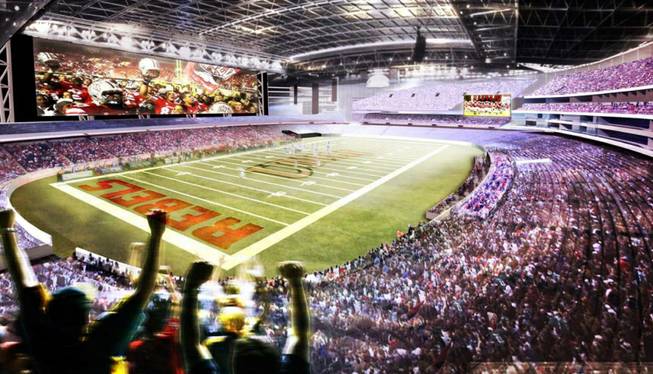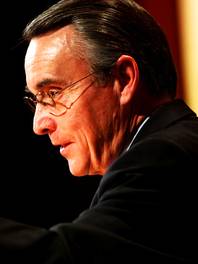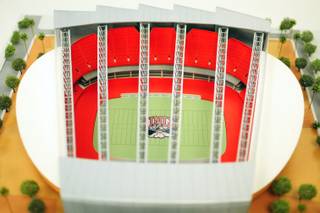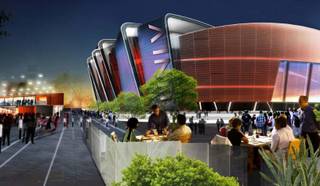
Majestic Realty Co.
A rendering of the proposed UNLV Now mega-events center shows how the stadium would look during a Rebels football game.
Friday, Feb. 15, 2013 | 2 a.m.

Donald Snyder
Related stories
- Rising costs of UNLV stadium project drive anxiety of resort industry (2-15-2013)
- Ray Brewer: Answering questions about the proposed UNLV Now stadium project (1-19-2013)
- Ray Brewer: New stadium would be major score for city, instant program changer for UNLV football (1-12-2013)
- Planned stadium will be state’s ‘next big thing,’ UNLV official says (1-12-2013)
- County commission OKs land deal for proposed UNLV stadium (11-20-2012)
Don Snyder is putting his head down and moving forward despite news this week that could cripple the UNLV Now stadium project he is trying to shepherd into reality.
MGM Resorts International, the first hotel-casino backer of UNLV Now, said it "cannot support the current UNLV Now concept," arguing its price tag of $800 million to $900 million was too prohibitive. The statement raised doubts about MGM's $20 million pledge for the "mega-events center."
In addition, the Nevada Resort Association and Las Vegas Convention and Visitors Authority tempered their endorsement of the 60,000-seat stadium. The LVCVA, from which stadium officials are planning to seek $125 million, said its first priority would be refurbishing the Las Vegas Convention Center, not funding the stadium.
"This certainly slows us down and sets us back," said Snyder, UNLV Now's project leader. "But it's not unusual in a project of this magnitude and complexity. It's a natural and important part of the process."
The public statements opposing the stadium caused UNLV Now officials to hastily cancel their scheduled meeting next week to discuss the project's final cost and funding plans with Nevada's higher education leaders. That Feb. 22 meeting — now postponed indefinitely — would have paved the way for a legislative debate this year on a special tax district to help finance the project.
The project suffered its first major setback in 2011 when it failed to secure legislative backing for a tax-increment financing district to pay for the UNLV stadium.
Legislators at the time were concerned about the cost and scope of the project. Bundled with two other stadium proposals in Las Vegas, UNLV's stadium bill failed in the final days of the 2011 session.
This time, Assembly Speaker Marilyn Kirkpatrick, D-North Las Vegas, is working with Snyder on a new bill for a tax district. That bill is "well advanced and close to ready to go," Snyder said.
But further delays in the cost and funding projections for the stadium could derail the bill in the budget-sensitive Legislature. If lawmakers fail to pass a bill this session, it could stall the stadium's construction for another two years.
"We don't have a lot of time. If everything isn't done this legislative session, we may need to go to the next session (in 2015)," Snyder said. "This is a large, complex and significant project. It's important for us to get it right than to try to hit a deadline."
Snyder, a former banker and casino executive who was instrumental in the development of several Las Vegas landmarks, recently stepped down as dean of UNLV's William F. Harrah College of Hotel Administration to focus his fundraising efforts on the stadium.
Snyder said he remains optimistic about the stadium's future despite this week's setbacks.
MGM's $20 million pledge was made about a year ago, Snyder said. The commitment created a lot of "positive energy" around the UNLV Now project, which helped move the planning and designs forward, he said.
However, since that pledge was made, the project has changed dramatically. The size and scope of the stadium, which would include the world's largest video screen, could have made private stakeholders uneasy.
"This is a very different project than when it was first envisioned," Snyder said. "The intensity of these conversations (surrounding the cost and scope) may have created a little bit of angst."
Withdrawal of MGM's support could have wider consequences for the planners, who are seeking millions of dollars in private support from Strip resorts.
About 40 percent of the stadium's cost will be borne by Majestic Realty's Ed Roski, who developed the Staples Center in Los Angeles. The remainder would come from the tax district, a portion of revenue generated by the stadium and private donations from Las Vegas' hospitality industry.
Lack of support from an initial investor and the largest casino company in Las Vegas could spook other major investors.
Snyder said his team, which includes Majestic, UNLV's private developer-partner, is working on "properly dialing in" a cost figure that works for everyone involved. Stadium officials might be forced to scale back the project to attract more private supporters.
"We have a lot of stakeholders. Everyone has different interests and needs," Snyder said. "The what is the easy part of the project. The how is the next and harder part."
Snyder, a former board member of the LVCVA, said he remained confident the resort industry would come around to the stadium project. He pointed to a University of Michigan study, commissioned by UNLV, that found the stadium could generate nearly $400 million annually in direct spending to the battered Las Vegas economy.
"This is a good economic engine for us in a time when we need it the most," Snyder said. "The faster we can have a facility that can attract more tourists, the faster we can get our economic engine going."



Join the Discussion:
Check this out for a full explanation of our conversion to the LiveFyre commenting system and instructions on how to sign up for an account.
Full comments policy